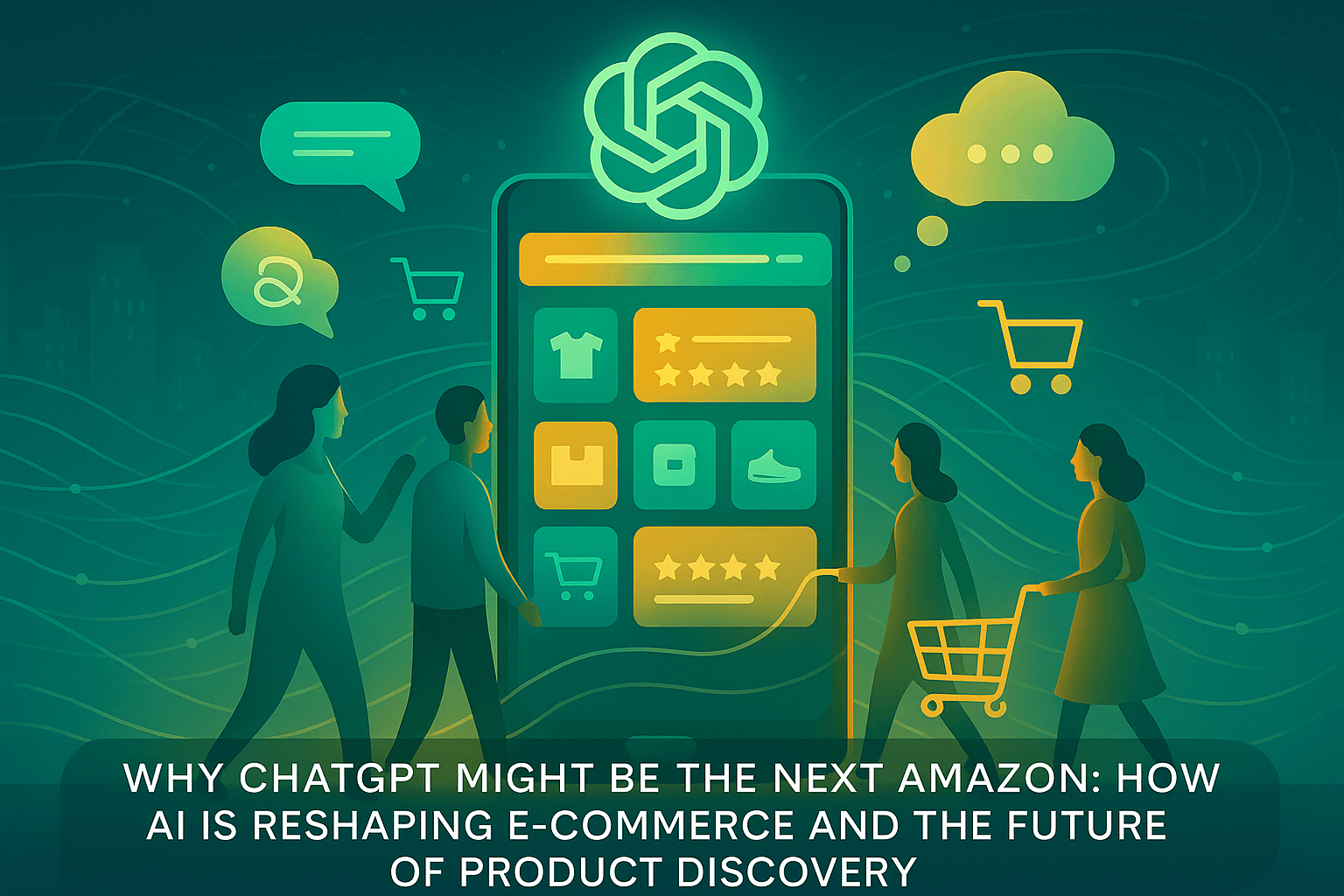Not a Search Box, But a Channel Shift
For more than two decades, the architecture of e-commerce has stayed largely the same: search, scroll, click, buy. Whether you’re on Amazon, Walmart, or a niche DTC site, the shopping journey still begins with a search bar, narrows through category filters, and ends with a product page. Everything about the e-commerce stack—from product information to marketing spend—is optimized around this model. Amazon perfected it. Google monetized it. And the rest of the digital retail world followed.
What happens when the interface changes—from search bars and filters to conversational interfaces like ChatGPT and voice assistants? Suddenly, shoppers aren’t just typing queries—they’re starting conversations.
ChatGPT doesn’t ask shoppers to search. It asks them to describe. The difference is more than surface-level—it’s a fundamental reordering of how product discovery works. In place of typing exact product names or brand SKUs, users now express intent: “I need boots that are good for winter hiking in wet conditions,” or “What’s a safe shampoo for color-treated hair?” What they get back isn’t a list of blue links or SKU tiles—it’s an answer. A narrative. A recommendation designed to guide customers through decision-making, not just present options. A recommendation generated in full context, pulling from multiple data sources, and shaped to the user’s specific need.
This shift isn’t just UX evolution—it’s proof that AI disrupts e-commerce at the interface level. Just as mobile disrupted desktop, and marketplaces disrupted brand-owned e-commerce, conversational AI is on track to disrupt both search and consumer behavior itself—changing how people express intent, make decisions, and explore products. And when the place where users begin their buying journey changes, everything downstream is up for grabs: visibility, influence, transaction volume, and even loyalty.
This isn’t hypothetical. We’re already seeing signs of change—and a generation of consumers beginning to expect smarter, more contextual buying experiences. Consumers are using AI—especially ChatGPT—to get product advice instead of Googling. Developers are building GPT plugins that link to live inventories and place real-time orders. Shopify is embedding AI into search and discovery. Amazon itself is testing ChatGPT-style experiences to protect its turf.
If you’re a retailer or manufacturer, the implications are clear. The shopping journey is no longer guaranteed to start with you—or even on your platform. Increasingly, it may start with a conversation. And that means you’re not competing for clicks anymore. You’re competing to be part of the answer.
ChatGPT vs Amazon: The Battle for the Start of the Buyer Journey
Amazon remains the most powerful digital retail engine in the world. Its strength lies in massive selection, rapid fulfillment, and decades of consumer trust. When someone knows what they want—a specific model, brand, or category—Amazon is often the first and fastest stop. That dominance is now facing a quiet but significant shift—not because Amazon is weaker, but because the customer journey is increasingly starting somewhere else: in AI-powered conversations.
That elsewhere is generative AI.
ChatGPT and similar models are not replacing Amazon’s backend infrastructure, logistics, or even its role in transactions—for now. But what they are disrupting is the intent layer of shopping: the early-stage discovery, research, and decision-making phase where preferences are formed and shortlists are made. In other words, what used to happen on search engines and inside Amazon’s own category pages is increasingly happening inside AI-driven interfaces.
People are now asking AI tools for help in selecting products based on highly specific needs and constraints—without knowing brand names or SKUs. Instead of searching “best hiking boots 2025,” they prompt: “I need waterproof hiking boots for cold climates with good ankle support and wide sizes.” ChatGPT responds with curated explanations, comparing features, offering pros and cons, and increasingly pointing to live product links through plugins and integrations. Amazon may be one of those sources—but it’s no longer the only source, nor is it guaranteed to be the final destination.
Recently, a lot of big stores and sites already had ChatGPT plugins and direct integrations set up. With these tools, users can look at product information, see what’s in stock, compare prices, and even buy things without leaving the ChatGPT interface. Amazon, on the other hand, is different. It still doesn’t have a native GPT interface. Instead, its conversational AI is only available on Alexa and the Amazon app. This means that it can’t be used by the rapidly rising number of AI-native users who are now using tools like ChatGPT to interact with AI.
The real disruption isn’t that ChatGPT is becoming a store. It’s that it’s becoming a decision layer—an intelligent filter between the buyer and the store. Amazon’s model is built around exposure and volume: get as many SKUs in front of the user as possible, often at the expense of a streamlined customer experience. ChatGPT’s model is the inverse: understand the need first, then reduce cognitive load by surfacing just a few aligned options. It doesn’t care how many listings exist—it cares which one best matches the prompt.
This shift threatens the two things Amazon relies on most: default traffic and habitual discovery. If buyers no longer start at Amazon—or if they arrive already biased by an AI-generated recommendation—then Amazon becomes a fulfillment layer, not a decision engine. That’s a very different competitive position.
This trend is quietly building its own large language models and experimenting with conversational shopping inside the app. But as of now, its ecosystem is still based on listing density and ad-driven visibility. ChatGPT, on the other hand, compresses the funnel. It answers instead of displaying. And that’s exactly why Amazon’s dominance—at least at the top of the journey—is no longer a given.
Conversational Commerce and AI-Powered Shopping
Conversational commerce isn’t new—we’ve seen chatbots, and shopping features pop up on social media for years. But for the most part, those early versions were pretty limited: slow, overly scripted, and not really connected to live inventory or actual buying processes. Most just handled FAQs or tried to collect leads.
That’s changed in a big way. Starting in late 2023, OpenAI’s ChatGPT Plugins and the GPTs platform opened the door to a whole new kind of shopping experience. These tools are smarter—they understand context, pull in real-time product data, and can actually get things done. These tools go beyond conversation—they plug into real-time data, link with APIs, and carry out real tasks seamlessly.
Here’s what has already changed the game:
- Shopify’s GPT Plugin lets store owners integrate ChatGPT with their product catalog. Users can ask high‑level questions (e.g. “What size motor fits this system?”), and ChatGPT can reference real-time inventory and quotes from the merchant—without shipping the user off to browse.
- Klarna’s integration enables conversational shopping across multiple brands. A user might ask, “I need a black leather sneaker under $200,” and get personalized recommendations with real‑time stock and shipping data—based on their unique preferences.
- Instacart’s plugin allows customers to ask about ingredients or meals in natural language, allowing customers to plan meals and fill carts in real time—without searching or browsing.
These are not prototypes—they’re in production, serving real users. They’re shaping what the conversational commerce future looks like—real-time, AI-guided, and interface-free. OpenAI has now extended this shift with Buy It in ChatGPT, embedding product discovery and checkout directly inside ChatGPT itself. They link natural language interfaces to e-commerce systems in a way that bypasses the traditional funnel:
homepage → category → search → cart.
What this means is that the entry point to commerce is shifting. Browsable grids and faceted navigation still matter—but only for those who start on retailer sites. A growing portion of commerce now begins with a conversational prompt on platforms that never show your homepage.
Amazon has long dominated e-commerce through scale and convenience—but it hasn’t opened itself up as a plugin to this new ecosystem. Its conversational experience remains siloed within Alexa or the Amazon app. Investors and industry watchers have pointed out that Amazon is putting serious effort into developing its own large language models—but as of mid-2025, it still hasn’t built any direct integrations with GPT-based assistants. Meanwhile, competitors and independent brands are already being surfaced in ChatGPT recommendation flows through integrations and plugins.
That shift transforms the competitive dynamic. Amazon becomes one of many possible sources, not the default. Because when AI recommends, it doesn’t prioritize storefront visibility or sponsored placement—it prioritizes fit. And when it answers, it reduces the role of discovery. That’s a fundamentally different power structure.
This isn’t about gimmicks anymore. It’s about intent-based intelligence built on real-time data. ChatGPT and its plugin ecosystem are showing how product suggestion, compatibility matching, bundling, pricing, and transaction can all be managed through dialogue. And that changes the rules for discovery, relevance, and ultimately, the future of retail.
What This Means for Retailers – The Disruption Isn’t Optional
For years, retailers calibrated their growth strategy around visibility—SEO, Google Shopping, Amazon Marketplace, and paid media. The goal was to get seen, get clicked, and convert before the buyer got distracted. But with the rise of generative AI—specifically ChatGPT as a product discovery engine—the entire upper funnel is being rewritten.
Retailers are no longer just competing for shelf space or ad slots. They’re competing to be included in a single AI-generated response. And that response doesn’t necessarily come from search engines or category pages—it comes from a model trained to reduce clutter and only show the “best” options based on context, need, and technical fit.
This shift poses two existential challenges:
Fewer brand touchpoints in the early journey.
When a shopper starts with ChatGPT, they often don’t see the retailer’s site at all. They describe their need, and the AI curates products, possibly using plugin data, external reviews, or aggregate spec information. Your branding, site UX, and merchandising are invisible unless your data is part of that curation layer.
No traditional opportunity to intercept.
If a shopper starts a query in ChatGPT and gets a tailored recommendation, they’re less likely to browse comparison sites, marketplaces, or search engines. That means no organic discovery, no PPC ad opportunity, no category listing to rank on. If you’re not part of the result, you’re not even in the running.
Retailers who treat ChatGPT as just another ‘marketing channel’ miss the point. This is how AI disrupts e-commerce—not by replacing platforms, but by rewriting how buyers make decisions. This isn’t a channel—it’s an interface shift. Like the move from desktop to mobile or to ecommerce marketplace selling, the emergence of AI as a decision layer changes how and where customer intent gets captured.
To remain relevant in this new landscape, retailers must reposition themselves—not as storefronts to be visited, but as data sources to be consulted. That requires a very different operational mindset.
- Your product catalog must be machine-readable and API-accessible.
- Your PDPs must go beyond marketing copy and include structured data that describes who the product is for, what problems it solves, and why it’s better.
- Your inventory, availability, and pricing data must be current and exposed through channels that AI models can query or be connected to—either through plugins, custom GPTs, or middleware APIs.
Retailers who invest in this shift early will benefit from what is essentially organic AI visibility—earning recommendations not because of paid placement or branding strength, but because their data best answers the customer’s request.
Retailers who fail to structure their catalogs for AI interfaces will find themselves increasingly invisible—not just to new customers, but to the systems those customers now trust most to make decisions.
How to Prepare—Structuring Product and Customer Data for AI eCommerce
The disruption isn’t speculative—it’s happening. ChatGPT and its ecosystem are already influencing product discovery and purchase decisions at scale. But most retailers haven’t adapted their internal systems to support this new interface layer. The good news? You don’t have to rebuild your storefront. But you do need to rethink what your ecommerce infrastructure is exposing—and to whom.
Here’s how to get started.
Turn Your Product Content into Structured, AI-Friendly Data
AI doesn’t “see” your product the way a person does. It doesn’t care about design, colors, or catchy copy; it only understands structured data.
If you want your products to show up in AI-powered search, recommendations, or chat-based tools, your content needs structure.
Start by breaking down your product detail pages into clearly labeled pieces, things like materials, dimensions, compatibility, certifications, common use cases, and who the product is actually for.
Don’t just organize products based on your internal taxonomy. Instead, tag and map attributes based on how real people search, shop, and compare, not how your backend system is structured.
Also, add schema markup and metafields that AI tools can easily understand. This makes your products more likely to show up in conversational search, voice queries, and AI-driven recommendations.
The more your product data reflects how people actually think and shop, the more likely AI is to surface your brand—not your competitor’s.
Open Up Your Product Catalog with API Access
If you want your products to show up in tools like ChatGPT—or any AI-powered shopping experience—your catalog needs to be accessible through an API. Whether that’s via GPT plugins, custom integrations, or middleware, making your product data easy for AI to access is a must.
- On Shopify? You’re in luck—its built-in APIs make it easy to get started. You can even create your own ChatGPT plugin using OpenAI’s plugin schema.
- Using a headless setup? Platforms like BigCommerce headless API or Contentful + Commerce Layer are perfect for this kind of dynamic exposure.
- Still on a legacy system? No problem. Use middleware to clean up and expose your data in a consistent, up-to-date format.
Think of your product catalog not just as inventory but as a structured knowledge base that AI tools need to query, reason over, and recommend from.
Give AI Context, Not Just Products
When someone asks ChatGPT, “What’s a good all-terrain stroller for both city sidewalks and rough trails?”—they’re not looking for a random SKU. They’re looking for the why behind a recommendation.
So make sure your product data includes:
- Use cases – “Great for hiking,” “Safe for indoor floors,” “Built for harsh weather”
- Problem-solving language – “Reduces setup time,” “Prevents backflow,” “Improves traction on uneven terrain”
- Comparative value – “30% lighter than others,” “More durable under repeated use,” “Better insulation than competing models”
This kind of descriptive, real-world context is what gives AI the material it needs to justify why your product is the right fit—not just list it.
Deploy Your Own GPT or Plugin
Some retailers are already ahead of the game. They’re building their own branded GPTs or ChatGPT plugins—creating intelligent, conversational layers that sit right on top of their catalog and store logic.
- A plugin can pull live inventory, filter products by user needs, and even launch a cart or checkout session.
- A custom GPT can be trained to understand your catalog inside and out—along with your buyer personas and brand voice.
- If you’re on Shopify, WooCommerce, or similar platforms, you can launch these tools directly through the ChatGPT Plugin Store or GPT Builder.
Owning this experience means you don’t wait to be discovered, you design how discovery works.
Make AI Discoverability a Team Sport
This isn’t just a job for the dev team. Marketing, product, merchandising, and customer support all play a part in helping your brand show up in AI-powered channels.
- Product marketers need to write content that makes sense to both people and machines.
- SEO teams should treat AI models as the new top-of-funnel.
- Support teams should contribute FAQs, objections, and troubleshooting info to the knowledge base, especially if it can be parsed by AI.
The goal isn’t to replace your existing store—it’s to make sure your store is visible, understandable, and valuable to the AI systems that are now sitting between you and your customer.
What Brands Gain If They Embrace This Shift
Retailers often approach major platform shifts—like mobile, headless, or marketplace integrations—with caution. But generative AI isn’t just another channel or traffic source.People’s purchasing decisions are changing as a result. Additionally, there are immediate and strategic benefits for brands that take the initiative and invest in making their products readable by AI systems.
1. Visibility Based on Recommendations, Not Ad-Based Noise
You didn’t “buy” the placement when ChatGPT recommended your product in response to a user prompt; rather, it did so because it was relevant, fit, and clear. Particularly for mid-sized brands that find it difficult to outbid rivals in ad auctions, this levels the playing field. The most beneficial product—not the loudest—is the one that emerges in an AI-driven world.
This implies that you don’t have to be the top search result. You must win the solution.
2. Higher Intent Conversions with Less Friction
Customers who arrive at your product through a ChatGPT-style interaction are typically more qualified. They’ve asked a specific question. They’ve been guided to a solution. And by the time they reach your site or product page, they’re already aligned with what the product does, why it solves their problem, and how to buy it.
This shortens the education cycle, reduces bounce rates, and increases conversion—without extra nurture steps.
3. Reduced Price Pressure Through Contextual Selling
On traditional marketplaces, pricing drives visibility. But conversational AI prioritizes fit. If your product solves a specific use case better than cheaper alternatives, ChatGPT will often surface it regardless of price—especially if the content backing that claim is structured and accessible.
That gives brands room to differentiate on value, not just discounting.
4. Better Brand Recall and Positioning
If you control your own GPT plugin or have well-indexed structured data, your product becomes the “go-to” answer for specific types of problems. That’s a branding effect—not just a conversion boost. Over time, customers begin to associate your name with expertise, trust, and relevance—building long-term customer engagement that extends beyond the initial purchase.
This is particularly powerful for technical or niche product categories where brand visibility is typically hard to earn.
5. Data-Driven Feedback Loops for Product and Content
By integrating with AI platforms, you can analyze the kinds of prompts that lead to your products. You’ll learn what language real users use to describe their needs, which features they prioritize, and where your catalog might be missing coverage—especially when layered with sentiment analysis of product prompts, objections, and user reviews.
This insight feeds back into everything: PDP copy, product design, customer support, and even R&D.
Retailers who lean into this shift won’t just maintain relevance, they’ll set the bar. As ChatGPT deliver better answers, it will become the one buyers trust, recommend, and return to.
AI-Ready Commerce Toolkit: Preparing for the Next Era of Buyer Behavior
Plugin & GPT Deployment Options
Choose your integration path for AI visibility depending on your platform.
| Stack Type | Deployment Option | Tools Needed |
| Shopify | GPT Plugin via Plugin Store | Shopify API, OpenAI plugin builder |
| BigCommerce (Headless) | Middleware or custom GPT integration | BigCommerce API, external layer |
| WooCommerce | GPT Plugin or 3rd-party connector | WooCommerce REST API, plugin scaffolds |
| Legacy Stack | Middleware-based exposure | Custom API endpoint + JSON schema definiti |
AI Discovery Optimization Priorities
Where should you focus your energy first? Use this as a roadmap.
Critical First Steps:
☐ Add natural language–friendly tags and specs to products
☐ Break descriptions into structured fields (not just one big text block)
☐ Make sure pricing, inventory, and specs are up-to-date across all SKUs
Next-Level Enhancements:
☐ Use “problem → solution” language in product copy
☐ Map categories to real-world buyer questions
☐ Add Q&A or FAQ fields to trigger conversational responses
Strategic Investments:
☐ Launch your own branded GPT for guided shopping
☐ Sync product data updates with plugin endpoints in real-time
☐ Track ChatGPT traffic and prompt behavior to inform strategy
New Commerce Mindset Alignment
AI is creating a new kind of shopping funnel. Here’s how it’s different—and what your team needs to adapt:
| Old Funnel (SEO/Search) | New Funnel (ChatGPT/AI) |
| Optimize for keywords | Optimize for question relevance |
| Focus on categories | Focus on specific buyer needs |
| Emphasize branding/visuals | Emphasize specs, context, and fit |
| Invest in paid traffic | Earn visibility through AI rankings |
| Buyer browses → clicks → buys | AI suggests → user acts → converts |
This isn’t just a new channel—it’s a new way to win. It’s less about getting seen and more about being selected.
This Isn’t the End of E-Commerce, It’s the Interface Reboot
E-commerce isn’t dying. But the interface we’ve relied on for two decades—search bars, filters, category menus—is being challenged in a serious, structural way. What once started with a Google search or a visit to Amazon is now just as likely to begin with a prompt: “What’s the best tool for cutting copper pipe in tight spaces?” or “I need a gift for a 9-year-old who loves building things.”
That’s not a search query. That’s a conversation. And in 2025, that conversation is happening more and more through tools like ChatGPT.
This shift doesn’t erase your existing commerce stack. Your website, your product pages, your fulfillment system—they still matter. But they’re no longer where the journey begins. The first moment of influence is now happening in the conversational layer. And when the interface changes, the advantage shifts—not to the biggest brand. Not to the cheapest SKU. But to the one who’s legible to the AI—structured, contextual, and relevant to the problem the user is trying to solve.
Just as mobile didn’t eliminate desktop, conversational AI won’t eliminate websites. But it will redefine where and how customers decide. The next wave of ecommerce growth isn’t about launching more storefronts—it’s about becoming part of the answer and earning a place in the AI-powered path to purchase.
In a world where the question comes first, your job isn’t simply to be found.
It’s to be chosen.
The brands that adapt fastest will own the conversation—and the customer. The rest will be invisible.
Contact us if you need help with AI overlays, plugins, or preparing your catalog for AI-driven commerce.












